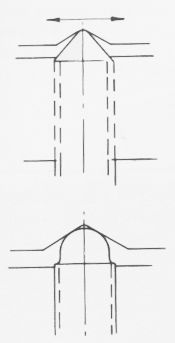I've got a super7 of late 1960s vintage, so it adopts the narrow guide saddle.
The saddle operates smoothly and there is no play when toward the headstock end and in the middle of the ways, but when I move it further than half way toward the tailstock it gets stiff, very stiff to the point that you don't want to crank it when it nears the tailstock.
Its a new machine to me, so I did some research and anticipated that the inner edge of the front way would be worn toward the HS, and that the tightness could be compounded by the narrow guide having been worn, mostly toward the tailstock.
Today, I stripped it down and to the naked eye the narrow guide looked near perfect. Unfortunately I do not have an appropriate micrometer to measure between the front edge of the saddle and the narrow guide, but I used a mitutoyo digital caliper on the gap at both ends and the middle (the readings will not be perfect, but they are averaged and I think fairly indicative of the gap). Toward the headstock I have 50.44mm and toward the tailstock 50.21mm. at the middle I have 50.3mm. according to these readings, the inner guide is actually less warn toward the tailstock, which surprised me but also reassured me that my eyes were working pretty well.
I then looked at the gap between the ways. Scraping marks from factory are present on inner edge of the rear way all along. Scraping marks are present on the inner edge of the front way from the tailstock to midway along toward the headstock, and then fade. I tried to get some representative readings from my digital caliper but it was no use. In any event, there was definitely some ware on the inner edge of the front way, but not a 'lot' – visually they look in good condition as well.
Latly, I used the tailstock to provide an indication of ware toward the headstock by adjusting the Gibs with the TS at its proper end – no play evident – and slid it all the way to the headstock -at that point, there was some play evident but a ' fairly' small amount, nothing drastic.
Ayways, my primary goal is to get this thing operating smooth allt he way to the tailstock end, and I was considering to alter the saddle to operate off the wide guide, i.e. the inside face of the rear way – but seeing that the saddle is not very worn, and the ways are also seemingly not 'that' worn, I wanted to make sure I wasn't overlooking anything first.
I'm relatively new to model engineering, so whilst I have a head scrrwed on (I think?!) I am not a machinist by trade, so apologies before hand if what I've said above doesn't make sense.
If anyone could point me in the right direct / share their thoughts on this situation and what I want to achieve in the end, I'd be very appreciative.
Cheers
Edit:
Two other things. Even with the saddle gib loosened off completely, there is a noticeable difference in effort required to wind the saddle toward the tailstock (from about 2/3 of the way along), and the gib strip looks brand new to me – it is approximately 4.58mm wide the entire length.
Edited By Jak2g on 16/12/2021 20:16:30
KWIL.






